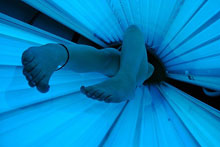Sunbed skin cancer risk double that of mediterranean midday summer sun
The average skin cancer risk from sunbeds is more than double that of spending the same length of time in the Mediterranean midday summer sun – according to new research from the University of Dundee and published today in the British Journal of Dermatology.

The study (1) tested levels of ultraviolet (UV) radiation from 400 sunbeds in England and found that nine in ten of the sunbeds tested emitted UV radiation at levels above British and EU standards. The average strength of radiation was approaching twice the recommended limit.
The Cancer Research UK study also compared the skin cancer risk from using these sunbeds with the risk from the Mediterranean midday summer sun. The average skin cancer risk from the sunbeds tested was more than twice that of spending the same length of time in the Mediterranean midday summer sun, with one of the sunbeds producing a skin cancer risk six times higher than the sun.
Professor Harry Moseley, consultant medical physicist at University of Dundee and lead author, said: “The development of high-power sunlamps, along with clear failures of the sunbed industry to regulate themselves effectively, is putting young people at an even greater risk of skin cancer than we previously thought.
“We hope that these findings will make people think twice before using sunbeds as you can’t be sure how much radiation you’re exposing yourself to when you try to top-up a tan. People need to be encouraged to take better care of their skin, otherwise the cases of malignant melanoma, the most dangerous form of skin cancer, will continue to increase in England.”
Yinka Ebo, senior health information officer at Cancer Research UK, said: “It’s worrying to see that so many sunbeds in England are not meeting the safety standards. This strengthens our advice that using a sunbed just isn’t worth it.
“Research has already shown that using sunbeds for the first time before the age of 35 increases the risk of malignant melanoma by 87 per cent. They’re not going to do you any good – the best case scenario is that they’ll age and damage your skin; the worst case scenario is a cancer diagnosis and potentially death.”
The strength of UV from sunbeds was found to be no different in those areas where the licensing of sunbeds is required compared to unlicensed areas.
The British and European standard (see Note) was introduced in 2003 and sets out a maximum level of UV radiation to be emitted by sunbeds used for cosmetic purposes. The findings suggest that there is much more work for local authorities to do to ensure that standards are being met by tanning businesses.
Nina Goad of the British Association of Dermatologists explained: “Product safety standards are there to protect the public and the government needs to step up its regulation of the industry.
“England is sadly trailing behind the rest of the UK in this matter. We need proper regulation, covering issues like safety of equipment and health warnings for clients and enforceable through inspections of premises.”
Reference
- Tierney, P., Ferguson, J. et al. (2013) Nine out of 10 sunbeds in England emit ultraviolet radiation levels that exceed current safety limits British Journal of Dermatology DOI: 10.1111/bjd.12181
Note
- BS EN 60335-2-27:2003 British Standard Institution BSI Household and Similar Electrical Appliances – Safety – Part 2-27: Particular requirements for appliances for skin exposure to ultraviolet and infrared radiation. The standard was endorsed by the European Union Scientific Committee on Consumer Products (SCCP): Opinion on Biological effects of ultraviolet radiation relevant to health with particular reference to sunbeds for cosmetic purposes. 2006: SCCP/0949/05. All EU member states, including the UK government agreed to introduce this level, from 1 April 2009, for all new and traded tanning devices.
Keywords: sunbeds, skin cancer risk, UV radiation
17. 1. 2013 Cancer Research UK Press Release



